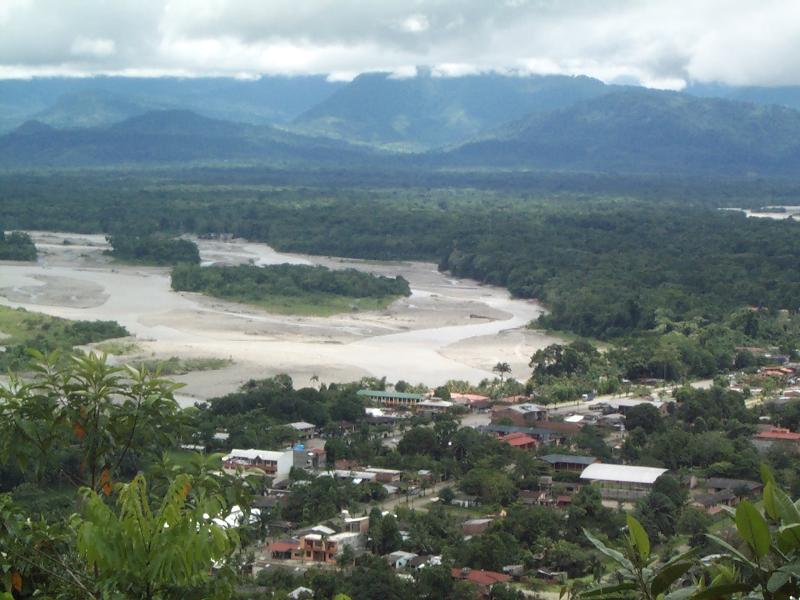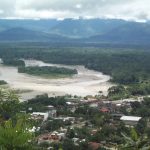Source: Andean Information Network
June 27, 2008
On June 24, 2008 coca grower unions of the Chapare region in Bolivia announced that they will no longer sign new aid agreements with USAID.[i] This announcement comes after two decades of poorly-focused policies, which did little to improve the lives of the majority of Chapare residents, especially during forced eradication. These development programs also provoked division and friction within the region by dividing communities and linking aid to controversial coca reduction. As a result, it is not surprising that Chapare coca growers made this decision; it is only surprising that they waited so long. Furthermore, the announcement is largely a symbolic gesture; USAID plans to shift the bulk of its already restricted Chapare activities to the La Paz Yungas in the coming year, and Chapare municipalities have found other funding partners.
According to the 2008 INSCR, “Relatively more resources will be devoted to the Yungas, an under-developed coca growing region ….Assistance to the Chapare will continue to decline….” As a result, the number and scope of projects affected is minimal.
It is interesting to note that there has been no rejection of cooperation with the U.S. Narcotics Affairs Section or the Drug Enforcement Agency (DEA) in the Chapare. Coca grower representatives affirm the need for their presence, “because their policy is to fight drug trafficking, like ours, but now it’s on our terms.”[ii] Coordination on cooperative coca reduction and interdiction remain unaltered.
It is crucial to look beyond the initial perception of an anti-American political stance to address the genuine popular discontent generated by these programs in order to properly re-evaluate the structure and impact of USAID initiatives. In an environment where the weight of US funding has diminished greatly, it makes sense to accept the Chapare farmers’ “no thank you,” and allow the region’s residents to determine who they would like to work with to improve the lives of their families.
The long term frustration with USAID in the Chapare is real, but the threat of violence is highly unlikely. There is no apparent backlash against USAID workers. According to MAS congressman Asterio Romero, “We cordially request that they (USAID) leave; we won’t use force or take over their facilities, but we want them to go quickly.”[iii] While some cocaleros may have said some provocative things such as calling the Chapare a “USAID-free territory,”[iv] USAID has not been entirely expelled from the Chapare – the few ongoing projects will most likely continue until their designated end dates. Coca growers are simply moving toward other sources of aid and away from the conditions and failures of USAID projects. The cocaleros made their decision to reject USAID at the same time that several large projects have ended and new projects through the European Union funded Social Control and Integrated Development initiatives – which focus on working with local communities and do not impose coca eradication – were launched.

A history of failure and friction
During the past ten years, AIN, WOLA and other investigators have repeatedly highlighted the inherent flaws of USAID alternative development initiatives in the Chapare, especially during forced eradication. Key areas of concern included:
* Externally-designed and imposed initiatives developed without significant consultation with Chapare farmers.
* The great majority of funds dedicated to overhead, salaries of foreign consultants and other costs. “Eighty percent of these resources went to pay the salaries of the Alternative Development personnel; twenty percent went to production, and only six percent for the producers. We only got crumbs, and we are still poor.”[v]
* From 1998-2003, farmers could only have access to USAID assistance after the complete eradication of their coca crop. As a result, families with no alternative income went hungry before agricultural initiatives kicked in, forcing them to replant coca.
* USAID projects refused to work directly with coca growers unions, although these strong organizations could have helped facilitate the implementation of projects. Instead, they formed parallel ‘associations” and demanded that farmers leave unions to receive assistance. This practice generated divisions and conflict within Chapare communities.
* Community promoters were asked to inform USAID contractors about their neighbors who continued to plant coca or spoke out against alternative development, further heightening tensions in the region.
* Poorly-designed agricultural initiatives lack affordable transportation mechanisms and markets. Many farmers found that it was cheaper to let their products rot in the field than it was to take them to market.
* The majority of these projects failed due to impracticality of transporting heavy produce without proper roads, the low-market price offered locally for fruit, and the inability for small-scale Bolivian producers to compete on international markets.
* A USAID contracted lawyer filed narcoterrorism charges against over one hundred coca growers, the bulk of the Six Federations leadership, for attacks on alternative development installations.
* USAID took over the bulk of the funding of FAO projects, like the Jatun Sacha forestry initiative, forcing the project to incorporate US conditioning on coca eradication.
* Unlike the more cost effective European Union initiative, Praedac, the US refused until 2003 to work with coca grower municipalities in the Chapare.
* USAID placed increasing emphasis on work with private enterprise in the Chapare, which failed to pass profits on to or fairly compensate their employees.
A short-lived policy shift
In late 2003, after the resignation of Gonzalo Sanchez de Lozada, USAID decided to begin to work collaboratively with coca grower municipalities in the Chapare, in an effort to alleviate the high tensions around US programs in the region. Coca growers welcomed the change and actively participated – a significant shift in acceptance of USAID initiatives in the region.
* Unfortunately, with the election of Evo Morales, USAID froze these joint initiatives for a year, wreaking havoc with municipal planning. In the interim, Chapare mayors sought out and obtained significant alternative funding from the EU, European governments and Venezuela, without any of the political strings and conditioning attached to US efforts.
* Even though they had frozen funding, the US claimed that the lack of violence in the region was due to “a new, integrated alternative development approach in the Chapare [which] provides for participation by municipalities in GOB decisions on development, implementation and monitoring of programs. This has helped reduce coca-related conflict and strengthen local commitment to licit development.”[vi] Coca growers were understandably angered by this misleading statement.
* When USAID initiatives resumed in the region, they were increasingly irrelevant. New requirements, such as renewed conditioning on coca reduction, although now on a global and not family level, and the obligation to sign an agreement certifying that recipient communities were “terrorist-free zones” exacerbated this situation.
In addition, after the election of Morales, USAID began to block meetings of NGOs, such as AIN and WOLA, with its Chapare contractors. When asked, one high-ranking USAID official in Bolivia explained that, “It would be problematic to allow contractors to speak in the name of the US government,” and said that AIN could tour alternative development facilities escorted by USAID personnel. This lack of transparency is quite surprising, considering that in prior years, both organizations had always had free access to all USAID projects, even during the peak of violent conflicts. AIN attempted to find contact information for over twenty USAID contractors within Bolivian, could only identify nine, and when contacted, only one organization accepted a meeting. This lack of transparency around USAID initiatives is problematic and inexplicable, when nongovernmental investigation in the past had led to significant improvement in programs.
With the history of failed alternative development, lack of transparency, and conditionality of coca eradication, it is hardly surprising that Chapare growers have rejected further ties to USAID funding. In a region where local unions and grassroots organizations were already highly politically mobilized, these programs served to undermine the history of community organizing. After living through the tensions and failures associated with USAID, Morales’ and his administration’s mistrust of USAID initiatives is hardly inexplicable. In light of repeated Morales administration accusations of USAID funding of the opposition’s political agendas, the proposed doubling of US assistance in the FY2009 Budget Request from economic development to “rule of law, good governance, electoral processes, consensus building, civil society and education,” has intensified these underlying tensions.
Chapare growers are moving toward different funding sources such as the European Union and Venezuela, which come with far less strings attached and do not condition assistance on reducing the coca crop. The MAS administration, while critical of many US policies and frustrated with conditional aid, continues to work with and receive funding from the US, especially anti-narcotics programs. Voices from the Chapare tell the real story. The mayor of Villa Tunari said, “We don’t want USAID anymore, if they are going to cooperate, it would have to be without conditions like the European Union.”[vii]
Time to re-evaluate US development initiatives
Although it may be tempting to characterize Chapare coca growers as ungrateful “beneficiaries,” blindly tied to their leader’s anti-US political agenda, their rejection of USAID projects is an important example of negative impact of development policy tied to political agendas. It is important to note that more pragmatic, grounded U.S.-funded development efforts in Bolivia, such as the Interamerican Foundation projects, continue to be well-received in all departments, and by MAS and prefectural officials. Especially on the eve of a national election, the predictable rejection of USAID assistance by coca growers should serve as a wake-up call to US planners and policymakers. It is crucial to reassess the design, orientation and objectives of US-funded development effects to meaningfully involve the participants and eliminate political conditioning.
Background reading on USAID Alternative Development in Bolivia
Failures of alternative development: Linda Farthing’s “Rethinking Alternative Development”
Political conditioning of USAID: Linda Farthing and Benjamin Kohl’s: “Conflicting Agenda’s: The Politics of Development Aid in Drug-Producing Areas”
Linda Farthing and Kathryn Ledebur’s: “The Beat goes On: The US War on Coca”
2006 USAID funding freeze and its impact: Coletta Youngers and Kathryn Ledebur: “Update on Drug Policy Issues in Bolivia”
Failures of USAID and potential benefits of EU projects: Kathryn Ledebur and Coletta A. Younger’s “Balancing Act: Bolivia’s Drug Control Advances and Challenges”





 Creative Commons Attribution
Creative Commons Attribution